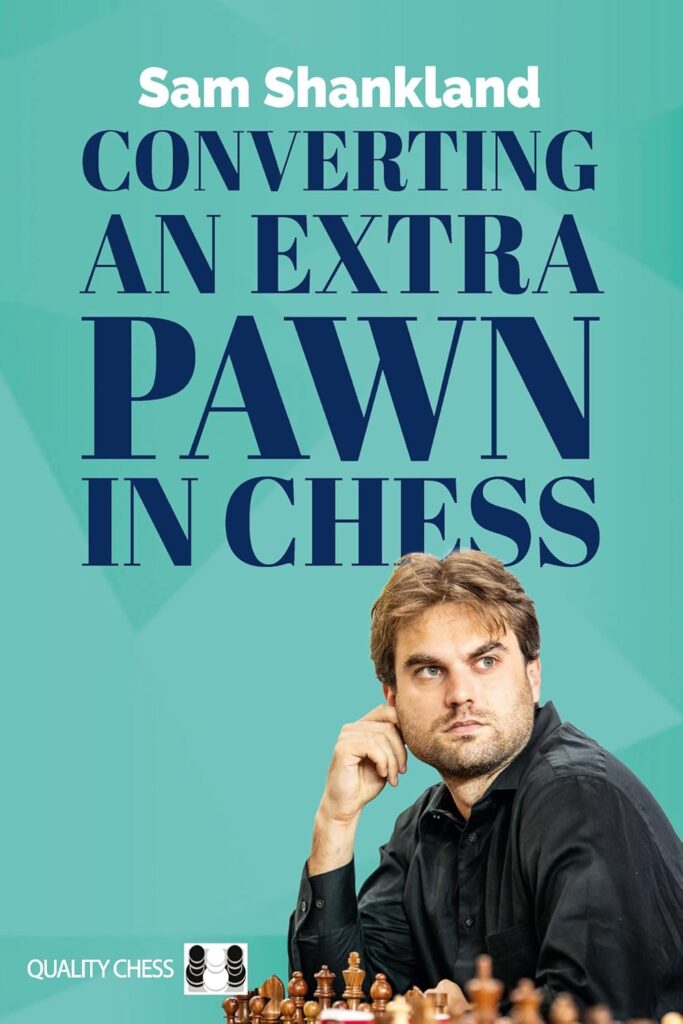Chess players of every level have faced the classic dilemma: you’ve worked hard to win a pawn, the position looks great, and the engine says you’re clearly better. But then… you somehow fail to convert. Either your opponent creates counterplay, or you don’t find the right plan, and the game fizzles into a draw. That’s exactly the challenge Sam Shankland tackles in his book Converting an Extra Pawn.
This book is not just another set of annotated games—it’s a structured manual on how to handle one of the most common yet frustrating tasks in practical play: turning that small edge into a full point. And it’s done in a way that feels both relatable and deeply instructive.

The Structure of the Book
Shankland divides the art of converting a pawn advantage into three main themes:
- Stabilize – First secure your position. Don’t allow counterplay or silly tactics. If you’re a pawn up but your opponent’s pieces are active, you might actually be worse.
- Make the Right Changes – Decide carefully which exchanges (pieces or pawns) help you, and which help your opponent. Sometimes swapping rooks makes your life easy, while other times it kills your winning chances.
- Plan for the Pawn – Finally, create a clear plan that shows why the extra pawn matters—whether it’s pushing it down the board, creating a passer, or using it to fix weaknesses in your opponent’s camp.
These three stages are not rigid rules, but guiding principles. Across 29 games—some from Shankland’s own career and others from legends like Carlsen, Kasparov, Karpov, and Anand—he demonstrates how top players deal with the same practical issues we face in our weekend games.
Why This Topic Matters
In the preface, Shankland openly admits that the inspiration for the book came from his own struggles and teaching. He first explored these ideas while giving a series of online classes at Killer Chess Training, and later refined them into this book.
What I liked here is the honesty. He doesn’t pretend converting an extra pawn is “easy.” Even super-GMs blunder with an extra pawn in hand. In fact, one line from the book really stuck with me: “Converting an extra pawn is an extremely difficult skill to master (just look at how many 2700+ players mess up in the upcoming games!)”. That line instantly makes you feel less bad about your own struggles.
The Teaching Style
The explanations are detailed and clear. Shankland has a talent for walking you through the thought process: why a certain exchange helps, why stabilizing first is necessary, and how to slowly build up pressure.
For example, in one of his own games against Lisandro Munuz (Miami 2009), he shows how winning a pawn was just the first step. After that, the critical decision wasn’t about flashy tactics, but about which pieces to trade and how to restrict the opponent’s counterplay.
This is a theme that runs throughout the book—Shankland doesn’t just show moves; he constantly asks questions: What’s my opponent’s plan? Which exchanges are favorable? What does my pawn want to achieve? Reading through feels almost like attending a training session rather than passively flipping through annotations.
What I Loved About the Book
- Practicality – This is not a “theory dump.” Every example is practical and rooted in positions you might actually get in your own games.
- Mix of Games – Shankland uses 10 of his own games, which gives the book a personal feel, but also includes classics from elite players, making it well-rounded.
- Honesty about Mistakes – He shows where he went wrong in his own games, and how engines later revealed improvements. This makes the lessons feel human and relatable.
- Step-by-Step Thinking – The three-part structure (Stabilize → Make the Right Changes → Plan for the Pawn) gives a repeatable thought process you can apply in real games.
Where It Could Have Been Better
That said, this isn’t the easiest book for complete beginners. At times, the analysis runs deep—several moves ahead with heavy engine-based evaluation. If you’re around 1200–1400, some of it may feel overwhelming. A few more “big picture” diagrams or summary lessons at the end of each chapter would have helped casual readers absorb the key takeaways without getting lost in variations.
Another small issue is that the book occasionally blends all three themes together within a single game. While that reflects the reality of chess, it can feel a little less structured for readers who like clean, chapter-by-chapter separation.
Who Should Read This Book
This book is perfect for:
- Intermediate to advanced club players (1600–2200 FIDE/online) who often win material but then struggle to convert.
- Serious tournament players who want to refine their technique and reduce the number of “half points” they drop from winning positions.
- Coaches and trainers, since the examples double as excellent training material for students.
If you’re below 1400, you might still enjoy the stories and examples, but a lot of the depth could go over your head. For absolute beginners, it’s better to first study endgame basics before jumping into this.
Final Thoughts
Sam Shankland’s Converting an Extra Pawn is a rare kind of chess book: practical, deeply instructive, and refreshingly honest. It tackles a universal problem that affects players from club level to grandmasters, and it gives you a framework to handle these positions better.
Will reading it instantly make you win every pawn-up endgame? No. But it will change how you think. You’ll start asking the right questions in your own games—“Is my position stable? Should I trade pieces? What’s the long-term plan for my pawn?”—and those questions alone can make a huge difference.
For me, this book strikes a balance between instructive analysis and relatable commentary. It’s not light reading, but if you put in the work, the rewards are real.
Rating: I’d happily give it 4.5/5 🌟. A must-read for serious improvers who are tired of letting their hard-earned extra pawns slip away.